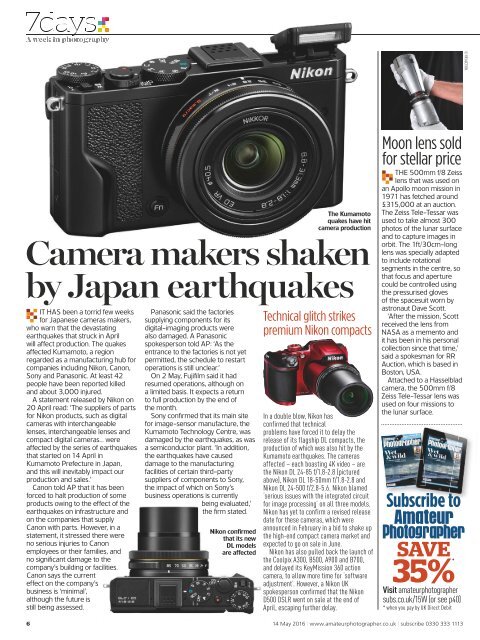Create successful ePaper yourself
Turn your PDF publications into a flip-book with our unique Google optimized e-Paper software.
© RR AUCTION<br />
Camera makers shaken<br />
by Japan earthquakes<br />
IT HAS been a torrid few weeks<br />
for Japanese cameras makers,<br />
who warn that the devastating<br />
earthquakes that struck in April<br />
will affect production. The quakes<br />
affected Kumamoto, a region<br />
regarded as a manufacturing hub for<br />
companies including Nikon, Canon,<br />
Sony and Panasonic. At least 42<br />
people have been reported killed<br />
and about 3,000 injured.<br />
A statement released by Nikon on<br />
20 April read: ‘The suppliers of parts<br />
for Nikon products, such as digital<br />
cameras with interchangeable<br />
lenses, interchangeable lenses and<br />
compact digital cameras… were<br />
affected by the series of earthquakes<br />
that started on 14 April in<br />
Kumamoto Prefecture in Japan,<br />
and this will inevitably impact our<br />
production and sales.’<br />
Canon told AP that it has been<br />
forced to halt production of some<br />
products owing to the effect of the<br />
earthquakes on infrastructure and<br />
on the companies that supply<br />
Canon with parts. However, in a<br />
statement, it stressed there were<br />
no serious injuries to Canon<br />
employees or their families, and<br />
no signifi cant damage to the<br />
company’s building or facilities.<br />
Canon says the current<br />
effect on the company’s<br />
business is ‘minimal’,<br />
although the future is<br />
still being assessed.<br />
Panasonic said the factories<br />
supplying components for its<br />
digital-imaging products were<br />
also damaged. A Panasonic<br />
spokesperson told AP: ‘As the<br />
entrance to the factories is not yet<br />
permitted, the schedule to restart<br />
operations is still unclear.’<br />
On 2 May, Fujifi lm said it had<br />
resumed operations, although on<br />
a limited basis. It expects a return<br />
to full production by the end of<br />
the month.<br />
Sony confi rmed that its main site<br />
for image-sensor manufacture, the<br />
Kumamoto Technology Centre, was<br />
damaged by the earthquakes, as was<br />
a semiconductor plant. ‘In addition,<br />
the earthquakes have caused<br />
damage to the manufacturing<br />
facilities of certain third-party<br />
suppliers of components to Sony,<br />
the impact of which on Sony’s<br />
business operations is currently<br />
being evaluated,’<br />
the fi rm stated.<br />
Nikon confirmed<br />
that its new<br />
DL models<br />
are affected<br />
The Kumamoto<br />
quakes have hit<br />
camera production<br />
Technical glitch strikes<br />
premium Nikon compacts<br />
In a double blow, Nikon has<br />
confirmed that technical<br />
problems have forced it to delay the<br />
release of its flagship DL compacts, the<br />
production of which was also hit by the<br />
Kumamoto earthquakes. The cameras<br />
affected – each boasting 4K video – are<br />
the Nikon DL 24-85 f/1.8-2.8 (pictured<br />
above), Nikon DL 18-50mm f/1.8-2.8 and<br />
Nikon DL 24-500 f/2.8-5.6. Nikon blamed<br />
‘serious issues with the integrated circuit<br />
for image processing’ on all three models.<br />
Nikon has yet to confirm a revised release<br />
date for these cameras, which were<br />
announced in February in a bid to shake up<br />
the high-end compact camera market and<br />
expected to go on sale in June.<br />
Nikon has also pulled back the launch of<br />
the Coolpix A300, B500, A900 and B700,<br />
and delayed its KeyMission 360 action<br />
camera, to allow more time for ‘software<br />
adjustment’. However, a Nikon UK<br />
spokesperson confirmed that the Nikon<br />
D500 DSLR went on sale at the end of<br />
April, escaping further delay.<br />
Moon lens sold<br />
for stellar price<br />
THE 500mm f/8 Zeiss<br />
lens that was used on<br />
an Apollo moon mission in<br />
1971 has fetched around<br />
£315,000 at an auction.<br />
The Zeiss Tele-Tessar was<br />
used to take almost 300<br />
photos of the lunar surface<br />
and to capture images in<br />
orbit. The 1ft/30cm-long<br />
lens was specially adapted<br />
to include rotational<br />
segments in the centre, so<br />
that focus and aperture<br />
could be controlled using<br />
the pressurised gloves<br />
of the spacesuit worn by<br />
astronaut Dave Scott.<br />
‘After the mission, Scott<br />
received the lens from<br />
NASA as a memento and<br />
it has been in his personal<br />
collection since that time,’<br />
said a spokesman for RR<br />
Auction, which is based in<br />
Boston, USA.<br />
Attached to a Hasselblad<br />
camera, the 500mm f/8<br />
Zeiss Tele-Tessar lens was<br />
used on four missions to<br />
the lunar surface.<br />
Subscribe to<br />
SAVE<br />
35%*<br />
Visit amateurphotographer<br />
subs.co.uk/15W (or see p40)<br />
* when you pay by UK Direct Debit<br />
6 14 May 2016 I www.amateurphotographer.co.uk I subscribe 0330 333 1113






